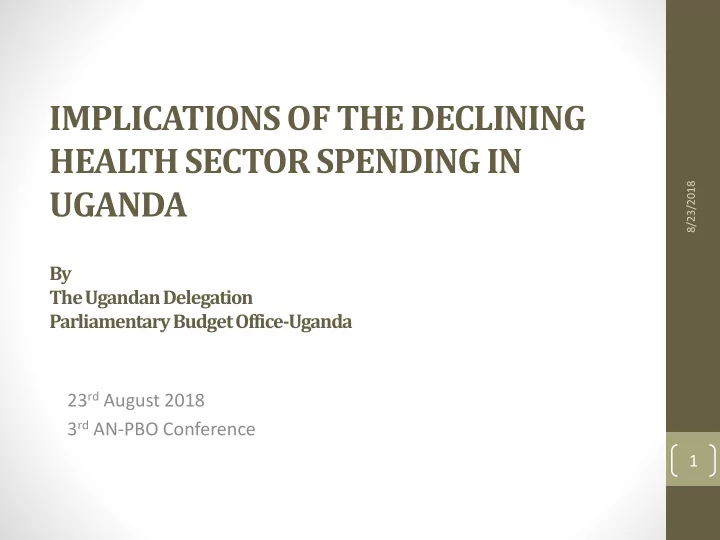

IMPLICATIONS OF THE DECLINING HEALTH SECTOR SPENDING IN 8/23/2018 UGANDA By The Ugandan Delegation Parliamentary Budget Office-Uganda 23 rd August 2018 3 rd AN-PBO Conference 1
Situation Analysis Demographic Variable Proportion Projected Population (2015) Total population 100% 35,756,800 8/23/2018 Males 48.6% 17,377,805 Females 51.4% 17,915,056 Children under 1 year 4.3% 1,537,542 Children under 5 years 17.7% 6,328,954 Children below 18 years 55.1% 19,701,996 Adolescents and youth (young people) (10 – 34.8% 12,443,366 24 years) Expected pregnancies 5% 1,787,840 Women of reproductive age(15-49 years) 20.2% 7,222,874 2
Situation Analysis- Cont … Key interventions: • Scaled up immunization, including introduction of the pneumococcal vaccine 8/23/2018 • Increased use of Long Lasting Insecticide Treated Nets (LLINs), • Elimination of mother to-child transmission of HIV (eMTCT), and • Improved water and sanitation. • Training programs for skilled birth attendants and other health workers launched by the MoH 3
Situation Analysis-Cont … Trends In Newborn, Infant And Child Mortality In Uganda per 1000 live births 8/23/2018 4
Sector Objectives The overall strategic direction for the sector is provided by the strategic objectives of the HSDP namely; • To contribute to production of a healthy human capital for wealth 8/23/2018 creation through provision of equitable, safe and sustainable health services. • To address the key determinants of health through strengthening inter-sectoral collaboration and partnerships. • To increase financial risk protection of households against impoverishment due to health expenditures. • To enhance the health sector competitiveness in the region and globally. 5
Health Spending in Uganda FY 2010/11 – FY 2015/16 and FY 2016/17 - 2021/22 (Ushs. bn) 2000.00 1837.90 1826.10 1800.00 8/23/2018 1702.20 1600.00 1565.00 1400.00 1353.801332.90 1281.14 1270.80 1200.00 1127.48 1000.00 852.20 800.00 799.11 660.00 600.00 400.00 200.00 6 0.00 2010/11 2011/12 2012/13 2013/14 2014/15 2015/16 2016/17 2017/18 2018/19 2019/20 2020/21 2021/22
Health Spending as a percentage of GDP 2.50% 8/23/2018 2.00% 1.92% 1.78% 1.61% 1.50% 1.29% 1.05% 1.00% 0.99% 0.86% 0.50% 7 0.00% 2015/16 2016/17 2017/18 2018/19 2019/20 2020/21 2021/22
Budget Proposals for the Health Sector Over the Medium Term (shs. bn) Category 2016/17 2017/18 2018/19 2019/20 2020/21 2021/22 Wage 373.0 384.1 400.8 418.4 436.9 456.4 8/23/2018 Non-wage 394.7 397.8 471.3 516.4 591.0 591.0 Domestic Devt 142.8 101.5 125.6 146.4 171.5 171.5 External Devt 903.1 912.7 681.1 457.2 124.9 82.4 Arrears 4.2 7.9 - - - - AiA 19.1 21.1 22.5 25.4 28.5 30.5 Total 1,837.9 1,826.1 1,702.2 1,565.0 1,353.8 1,332.9 Total Exp / GDP 8 1.92% 1.78% 1.61% 1.29% 0.99% 0.86%
Assumption and Questions Assumption: • There is a reduction in funding to the health sector by 7.47% (nominal) 14.54% (real), on annual average over the medium term. 8/23/2018 Questions: • What is the implication of declining funding to the Health Sector? • What happens to Labour Productivity, Real GDP, Employment and Capital Stock in the Country? • Which Sectors will be affected and to what extent? What happens? 9
Methodology • Utilized the Integrated Macroeconomic Model for Uganda • Macro and Computable General Equilibrium (CGE) models • Macro-Model to obtain a set of forecast results over a chosen 8/23/2018 time horizon • CGE model with Economic Agents (Producers, Investors, Household, Export, Government and Stocks) • CGE model with 72 commodities, • CGE model to create and run a baseline simulation • Using the CGE model, run a policy simulation incorporating the baseline features and a policy shock 10
Payment flows in CGE model (simplified) Factor Domestic Private Savings Markets Factor Wages Costs & Rents Gov. Savings Taxes Intermediate Households Government Sav./Inv. Input Cost Activities Transfers Private Government Investment Product Consumption Demand Consumption Markets Domestic Sales Imports Foreign Transfers Exports Foreign Savings Rest of the World
Impact on the Economy Percentage Change - Wages and Employment (Health Sector) 8/23/2018 12
Impact on the Economy –Cont.… Percentage Change - Real GDP, Employment and Capital Stock 8/23/2018 13
Impact on the Economy –Cont.… Employment in selected 8 sectors 8/23/2018 14
Conclusion • The health sector in Uganda has registered significant progress based on outcome indicators, however, sustainability of this 8/23/2018 progress will depend on how government sustains public investments and interventions that have propelled the country towards this progress. • Any decline in the productivity in the health sector has consequences in other sectors like Agriculture, Oil and Gas, and Manufacturing, as switches to construction and mining sectors. 15
Recommend
More recommend